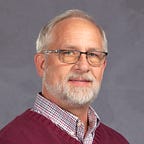Renowned ‘Farmer Sculptor’ hailed from Berwick
BERWICK, Ill. — Just as the works of Ernest Hemingway and Jack London achieved their power from the writers’ personal experiences, the works of Ben D. Cable earned him the title “the Farmer Sculptor.”
Born on a farm just north of Berwick in 1865, Benjamin Davis Cable showed an aptitude for drawing and painting from an early age, while attending the district school in Floyd Township. A voracious reader, he schooled himself on all aspects of the arts, and in his spare time on the farm took up sketching farm animals and wildlife.
Cable soon graduated to clay and became a master of modeling the muscles, sinews and coats of horses and other powerful but graceful animals. Like many young men in Warren County, he was a devotee of harness racing, attending races at the fairgrounds south of Monmouth. He also read the racing papers and at age 21 traveled to Louisville, Kentucky, for a historic, nationally-advertised sale of champion trotter studs, broodmares and young stock.
As Cable’s expertise in clay modeling increased, he began turning his works into plaster sculptures and entered them in competitions at the Art Institute of Chicago. He soon caught the attention of renowned sculptor Lorado Taft, a native of nearby Elmwood, who was affiliated with the institute. Taft encouraged him to further develop his craft and start casting his models into bronze. Cable eventually developed a following, particularly among wealthy breeders, who commissioned statues of their champion horses.
After the death of their father in 1900, Ben and his brother Arthur became co-managers of the family farm, but by 1902 they had moved to Omaha, where they engaged for a time in the stock commission business and raising sheep. In that year the art critic of the Daily Bee wrote glowingly about a wax sculpture of a Ramboillet ram by Cable that was displayed in an Omaha store window, and comparing the artist to the renowned animal sculptor Edward Kemeys, who created the famous lions flanking the entrance to the Chicago Art Institute.
One of Cable’s favorite animals to sculpt was the elk, perhaps stemming from his membership in the Monmouth Elks lodge. In 1905, he traveled to the Lewis and Clark Centennial exposition in Portland, Oregon, where he watched Professor Barnes’ trained diving elks leap from a 40-foot platform into a 16-square-foot tank. On a later occasion, he visited the grounds of Soangetaha Country Club in Galesburg to make sketches of a large bull elk that was kept there in a wire stockade. The elk got so accustomed to his visits that it would come up alongside the fence and lie down in front of him, as if posing.
After a short stint in Nebraska, Cable and his brother returned to the Floyd Township farm, but he increasingly frequented Chicago, where he maintained a studio and became a member of the renowned Cliff Dwellers private club of artists. His entry into the Art Institute’s 1910 competition won him national recognition, as his plaster sculpture titled “Homeward” won the Mrs. Lyman A. Walton prize and was pictured in Harper’s Monthly magazine.
The simple but elegant sculpture depicted a weathered old farmer leading his weathered old horse home from the field at the end of the day, a subject that was no doubt very familiar to Cable.
Another of his famous sculptures, purchased by Detroit capitalist George J. Moore, was a bronze titled “Maternity,” showing a standing mare watching over her newborn colt. In addition to horses and elk, his subjects ranged from bison to bears to a hawk, to even a diminutive mouse.
Because of the cost of casting his sculptures in bronze, the majority of Cable’s work never advanced beyond the plaster stage. One such example was a masterful piece depicting a Roman centurion mounted upon a massive battle horse.
Ben Cable never married, nor did his brother Arthur, and the two lived together as bachelor farmers on the family land, which had been developed by their father in the 1830s. Although he was repeatedly urged by friends to become a full-time artist, his first priority always remained caring for the land and the livestock.
In later years, the brothers were joined on the farm by their younger sister, Era Cable Peirce, and her three sons — Henry, Richard and George — who did the active farming.
In the winter of 1937, Cable spent time at the Coldstream Farm near Lexington, Kentucky, where he modeled sculptures of two famous racehorses. The following August he suffered a heart attack, dying in the same home near Berwick in which he had been born, 72 years earlier.
Jeff Rankin is an editor and historian for Monmouth College. He has been researching, writing and speaking about western Illinois history for more than 40 years.
